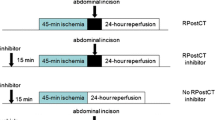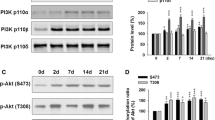Abstract
Deciphering the remote conditioning molecular mechanism may provide targets to develop therapeutics that can broaden the clinical application. To further investigate this, we tested whether two protein kinase C (PKC) isozymes, the ubiquitously expressed epsilon PKC (εPKC) and the neuronal-specific gamma PKC (γPKC), mediate nociceptive-induced remote myocardial conditioning. Male Sprague-Dawley rats were used for both in vivo and ex vivo myocardial ischemia–reperfusion protocols. For the in vivo studies, using a surgical abdominal incision for comparison, applying only to the abdomen either bradykinin or the εPKC activator (ψεRACK) reduced myocardial infarct size (45 ± 1, 44 ± 2 %, respectively, vs. incision: 43 ± 2 %, and control: 63 ± 2 %, P < 0.001). Western blot showed only εPKC, and not γPKC, is highly expressed in the myocardium. However, applying a selective γPKC inhibitor (γV5−3) to the abdominal skin blocked remote protection by any of these strategies. Using an ex vivo isolated heart model without an intact nervous system, only selective εPKC activation, unlike a selective classical PKC isozyme activator (activating α, β, βII, and γ), reduced myocardial injury. Importantly, the classical PKC isozyme activator given to the abdomen in vivo (with an intact nervous system including γPKC) during myocardial ischemia reduced infarct size as effectively as an abdominal incision or ψεRACK (45 ± 1 vs. 45 ± 2 and 47 ± 1 %, respectively). The classical PKC activator-induced protection was also blocked by spinal cord surgical transection. These findings identified potential remote conditioning mimetics, with these strategies effective even during myocardial ischemia. A novel mechanism of nociceptive-induced remote conditioning, involving γPKC, was also identified.








Similar content being viewed by others
References
Aronowski J, Grotta JC, Strong R, Waxham MN (2000) Interplay between the gamma isoform of PKC and calcineurin in regulation of vulnerability to focal cerebral ischemia. J Cereb Blood Flow Metab 20:343–349. doi:10.1097/00004647-200002000-00016
Budas GR, Churchill EN, Mochly-Rosen D (2007) Cardioprotective mechanisms of PKC isozyme-selective activators and inhibitors in the treatment of ischemia-reperfusion injury. Pharmacol Res 55:523–536
Budas GR, Churchill EN, Disatnik MH, Sun L, Mochly-Rosen D (2010) Mitochondrial import of PKCε is mediated by HSP90: a role in cardioprotection from ischemia and reperfusion injury. Cardiovasc Res. doi:10.1093/cvr/cvq154
Cesare P, Dekker LV, Sardini A, Parker PJ, McNaughton PA (1999) Specific involvement of PKC-epsilon in sensitization of the neuronal response to painful heat. Neuron 23:617–624
Chen C, Kano M, Abeliovich A, Chen L, Bao S, Kim JJ, Hashimoto K, Thompson RF, Tonegawa S (1995) Impaired motor coordination correlates with persistent multiple climbing fiber innervation in PKC gamma mutant mice. Cell 83:1233–1242. doi:10.1016/0092-8674(95)90148-5
Chen CH, Budas GR, Churchill EN, Disatnik MH, Hurley TD, Mochly-Rosen D (2008) Activation of aldehyde dehydrogenase-2 reduces ischemic damage to the heart. Science 321:1493–1495. doi:10.1126/science.1158554
Chen L, Hahn H, Wu G, Chen CH, Liron T, Schechtman D, Cavallaro G, Banci L, Guo Y, Bolli R, Dorn GW 2nd, Mochly-Rosen D (2001) Opposing cardioprotective actions and parallel hypertrophic effects of delta PKC and epsilon PKC. Proc Natl Acad Sci 98:11114–11119. doi:10.1073/pnas.191369098
Contractor H, Stottrup NB, Cunnington C, Manlhiot C, Diesch J, Ormerod JO, Jensen R, Botker HE, Redington A, Schmidt MR, Ashrafian H, Kharbanda RK (2013) Aldehyde dehydrogenase-2 inhibition blocks remote preconditioning in experimental and human models. Basic Res Cardiol 108:343. doi:10.1007/s00395-013-0343-3
Cui W, Li Y, Li S, Yang W, Jiang J, Han S, Li J (2009) Systemic lidocaine inhibits remifentanil-induced hyperalgesia via the inhibition of cPKCgamma membrane translocation in spinal dorsal horn of rats. J Neurosurg Anesthesiol 21:318–325. doi:10.1097/ANA.0b013e3181abbde5
Dalski A, Mitulla B, Burk K, Schattenfroh C, Schwinger E, Zuhlke C (2006) Mutation of the highly conserved cysteine residue 131 of the SCA14 associated PRKCG gene in a family with slow progressive cerebellar ataxia. J Neurol 253:1111–1112. doi:10.1007/s00415-006-0209-9
Dorn GW 2nd, Souroujon MC, Liron T, Chen CH, Gray MO, Zhou HZ, Csukai M, Wu G, Lorenz JN, Mochly-Rosen D (1999) Sustained in vivo cardiac protection by a rationally designed peptide that causes epsilon protein kinase C translocation. Proc Natl Acad Sci 96:12798–12803. doi:10.1073/pnas96.22.12798
Ferguson RE, Carroll HP, Harris A, Maher ER, Selby PJ, Banks RE (2005) Housekeeping proteins: a preliminary study illustrating some limitations as useful references in protein expression studies. Proteomics 5:566–571. doi:10.1002/pmic.200400941
Ferreira JC, Boer BN, Grinberg M, Brum PC, Mochly-Rosen D (2012) Protein quality control disruption by PKCbetaII in heart failure; rescue by the selective PKCbetaII inhibitor, betaIIV5-3. PLoS ONE 7:e33175. doi:10.1371/journal.pone.0033175
Gray MO, Karliner JS, Mochly-Rosen D (1997) A selective ε-protein kinase C antagonist inhibits protection of cardiac myocytes from hypoxia-induced cell death. J Biol Chem 272:30945–30951. doi:10.1074/jbc.272.49.30945
Gross ER, Hsu AK, Gross GJ (2007) GSK3beta inhibition and K(ATP) channel opening mediate acute opioid-induced cardioprotection at reperfusion. Basic Res Cardiol 102:341–349. doi:10.1007/s00395-007-0651-6
Gross GJ, Baker JE, Moore J, Falck JR, Nithipatikom K (2011) Abdominal surgical incision induces remote preconditioning of trauma (RPCT) via activation of bradykinin receptors (BK2R) and the cytochrome P450 epoxygenase pathway in canine hearts. Cardiovasc Drugs Ther 25:517–522. doi:10.1007/s10557-011-6321-9
Gross GJ, Hsu A, Gross ER, Falck JR, Nithipatikom K (2012) Factors mediating remote preconditioning of trauma in the rat heart: central role of the cytochrome P450 epoxygenase pathway in mediating infarct size reduction. J Cardiovasc Pharmacol Ther 38–45. doi:10.1177/1074248412437586
Hambleton M, Hahn H, Pleger ST, Kuhn MC, Klevitsky R, Carr AN, Kimball TF, Hewett TE, Dorn GW 2nd, Koch WJ, Molkentin JD (2006) Pharmacological- and gene therapy-based inhibition of protein kinase Calpha/beta enhances cardiac contractility and attenuates heart failure. Circulation 114:574–582. doi:10.1161/CIRCULATIONAHA.105.592550
Hayashi S, Ueyama T, Kajimoto T, Yagi K, Kohmura E, Saito N (2005) Involvement of gamma protein kinase C in estrogen-induced neuroprotection against focal brain ischemia through G protein-coupled estrogen receptor. J Neurochem 93:883–891. doi:10.1111/j.1471-4159.2005.03080.x
Heusch G, Musiolik J, Kottenberg E, Peters J, Jakob H, Thielmann M (2012) STAT5 activation and cardioprotection by remote ischemic preconditioning in humans: short communication. Circ Res 110:111–115. doi:10.1161/CIRCRESAHA.111.259556
Heusch G (2013) Cardioprotection: chances and challenges of its translation to the clinic. Lancet 381:166–175. doi:10.1016/S0140-6736(12)60916-7
Inagaki K, Hahn HS, Dorn GW 2nd, Mochly-Rosen D (2003) Additive protection of the ischemic heart ex vivo by combined treatment with delta-protein kinase C inhibitor and epsilon-protein kinase C activator. Circulation 108:869–875. doi:10.1161/01.CIR.0000081943.93653.73
Inagaki K, Begley R, Ikeno F, Mochly-Rosen D (2005) Cardioprotection by epsilon-protein kinase C activation from ischemia: continuous delivery and antiarrhythmic effect of an epsilon-protein kinase C-activating peptide. Circulation 111:44–50. doi:10.1161/01.CIR.0000151614.22282.F1
Jeske NA, Patwardhan AM, Ruparel NB, Akopian AN, Shapiro MS, Henry MA (2009) A-kinase anchoring protein 150 controls protein kinase C-mediated phosphorylation and sensitization of TRPV1. Pain 146:301–307. doi:10.1016/j.pain.2009.08.002
Jones WK, Fan GC, Liao S, Zhang JM, Wang Y, Weintraub NL, Kranias EG, Schultz JE, Lorenz J, Ren X (2009) Peripheral nociception associated with surgical incision elicits remote nonischemic cardioprotection via neurogenic activation of protein kinase C signaling. Circulation 120:S1–S9. doi:10.1161/CIRCULATIONAHA.108.843938
Li HF, Mochly-Rosen D, Kendig JJ (2005) Protein kinase Cγ mediates ethanol withdrawal hyper-responsiveness of NMDA receptor currents in spinal cord motor neurons. Br J Pharmacol 144:301–307. doi:10.1038/sj.bjp.0706033
Li LF, Fiedler VC, Kumar R (1998) Down-regulation of protein kinase C isoforms in irritant contact dermatitis. Contact Dermatitis 38:319–324
Lim SY, Yellon DM, Hausenloy DJ (2010) The neural and humoral pathways in remote limb ischemic preconditioning. Basic Res Cardiol 105:651–655. doi:10.1007/s00395-010-0099-y
Lin D, Barnett M, Lobell S, Madgwick D, Shanks D, Willard L, Zampighi GA, Takemoto DJ (2006) PKCγ knockout mouse lenses are more susceptible to oxidative stress damage. J Exp Biol 209:4371–4378. doi:10.1242/jeb.02524
Liu GS, Cohen MV, Mochly-Rosen D, Downey JM (1999) Protein kinase C-epsilon is responsible for the protection of preconditioning in rabbit cardiomyocytes. J Mol Cell Cardiol 31:1937–1948. doi:10.1006/jmcc.1999.1026S002228289991026X
Malmberg AB, Chen C, Tonegawa S, Basbaum AI (1997) Preserved acute pain and reduced neuropathic pain in mice lacking PKCγ. Science 278:279–283. doi:10.1126/science.278.5336.279
Mao J, Price DD, Phillips LL, Lu J, Mayer DJ (1995) Increases in protein kinase C gamma immunoreactivity in the spinal cord of rats associated with tolerance to the analgesic effects of morphine. Brain Res 677:257–267. doi:10.1016/0304-3940(95)11975-3
Miraucourt LS, Dallel R, Voisin DL (2007) Glycine inhibitory dysfunction turns touch into pain through PKCγ interneurons. PLoS ONE 2:e1116. doi:10.1371/journal.pone.0001116
Neumann S, Braz JM, Skinner K, Llewellyn-Smith IJ, Basbaum AI (2008) Innocuous, not noxious, input activates PKCγ interneurons of the spinal dorsal horn via myelinated afferent fibers. J Neurosci 28:7936–7944. doi:10.1523/JNEUROSCI.1259-08.2008
Peart JN, Gross ER, Reichelt ME, Hsu A, Headrick JP, Gross GJ (2008) Activation of κ-opioid receptors at reperfusion affords cardioprotection in both rat and mouse hearts. Basic Res Cardiol 103:454–463. doi:10.1007/s00395-008-0726-z
Polgar E, Fowler JH, McGill MM, Todd AJ (1999) The types of neuron which contain protein kinase C gamma in rat spinal cord. Brain Res 833:71–80. doi:10.1016/S0006-8993(99)01500-0
Qi X, Disatnik MH, Shen N, Sobel RA, Mochly-Rosen D (2011) Aberrant mitochondrial fission in neurons induced by protein kinase Cδ under oxidative stress conditions in vivo. Mol Biol Cell 22:256–265. doi:10.1091/mbc.E10-06-0551
Redington KL, Disenhouse T, Strantzas SC, Gladstone R, Wei C, Tropak MB, Dai X, Manlhiot C, Li J, Redington AN (2012) Remote cardioprotection by direct peripheral nerve stimulation and topical capsaicin is mediated by circulating humoral factors. Basic Res Cardiol 107:241. doi:10.1007/s00395-011-0241-5
Ron D, Chen CH, Caldwell J, Jamieson L, Orr E, Mochly-Rosen D (1994) Cloning of an intracellular receptor for protein kinase C: a homolog of the beta subunit of G proteins. Proc Natl Acad Sci 91:839–843. doi:10.1073/pnas91.3.839
Ron D, Luo J, Mochly-Rosen D (1995) C2 region-derived peptides inhibit translocation and function of beta protein kinase C in vivo. J Biol Chem 270:24180–24187. doi:10.1074/jbc.270.41.24180
Rybin VO, Steinberg SF (1994) Protein kinase C isoform expression and regulation in the developing rat heart. Circ Res 74:299–309
Schechtman D, Craske ML, Kheifets V, Meyer T, Schechtman J, Mochly-Rosen D (2004) A critical intramolecular interaction for protein kinase Cε translocation. J Biol Chem 279:15831–15840. doi:10.1074/jbc.M310696200
Skyschally A, van Caster P, Boengler K, Gres P, Musiolik J, Schilawa D, Schulz R, Heusch G (2009) Ischemic postconditioning in pigs: no causal role for RISK activation. Circ Res 104:15–18. doi:10.1161/CIRCRESAHA.108.186429
Souroujon MC, Mochly-Rosen D (1998) Peptide modulators of protein–protein interactions in intracellular signaling. Nat Biotechnol 16:919–924. doi:10.1038/nbt1098-919
Sweitzer SM, Wong SM, Peters MC, Mochly-Rosen D, Yeomans DC, Kendig JJ (2004) Protein kinase C ϵ and γ: involvement in formalin-induced nociception in neonatal rats. J Pharmacol Exp Ther 309:616–625. doi:10.1124/jpet.103.060350
Thielmann M, Kottenberg E, Boengler K, Raffelsieper C, Neuhaeuser M, Peters J, Jakob H, Heusch G (2010) Remote ischemic preconditioning reduces myocardial injury after coronary artery bypass surgery with crystalloid cardioplegic arrest. Basic Res Cardiol 105:657–664. doi:10.1007/s00395-010-0104-5
Vahlhaus C, Schulz R, Post H, Onallah R, Heusch G (1996) No prevention of ischemic preconditioning by the protein kinase C inhibitor staurosporine in swine. Circ Res 79:407–414
Wang Y, Wu J, Guo R, Zhao Y, Wang Y, Zhang M, Chen Z, Wu A, Yue Y (2013) Surgical incision induces phosphorylation of AMPA receptor GluR1 subunits at Serine-831 sites and GluR1 trafficking in spinal cord dorsal horn via a protein kinase Cγ-dependent mechanism. Neuroscience 240:361–370. doi:10.1016/j.neuroscience.2013.02.051
Wessendorf MW, Dooyema J (2001) Coexistence of κ- and δ-opioid receptors in rat spinal cord axons. Neurosci Lett 298:151–154. doi:10.1016/S0304-3940(00)01700-6
Xu TR, He G, Rumsby MG (2009) Adenosine triggers the nuclear translocation of protein kinase C epsilon in H9c2 cardiomyoblasts with the loss of phosphorylation at Ser729. J Cell Biochem 106:633–642. doi:10.1002/jcb.22043
Zhang N, Yin Y, Han S, Jiang J, Yang W, Bu X, Li J (2011) Hypoxic preconditioning induced neuroprotection against cerebral ischemic injuries and its cPKCγ-mediated molecular mechanism. Neurochem Int 58:684–692. doi:10.1016/j.neuint.2011.02.007
Acknowledgments
This manuscript was supported in part by NIH HL52141 (DMR), NIH HL109212 (ERG), and NIH HL74314 (GJG). ERG, AKH, TJU and GJG have no disclosures. A preliminary US patent was filed based on findings in the manuscript.
Author information
Authors and Affiliations
Corresponding author
Electronic supplementary material
Below is the link to the electronic supplementary material.
Rights and permissions
About this article
Cite this article
Gross, E.R., Hsu, A.K., Urban, T.J. et al. Nociceptive-induced myocardial remote conditioning is mediated by neuronal gamma protein kinase C. Basic Res Cardiol 108, 381 (2013). https://doi.org/10.1007/s00395-013-0381-x
Received:
Revised:
Accepted:
Published:
DOI: https://doi.org/10.1007/s00395-013-0381-x




